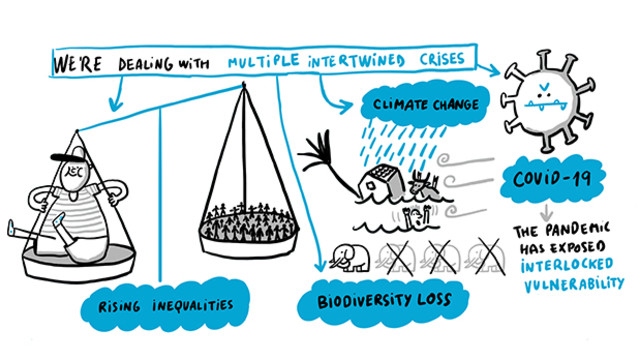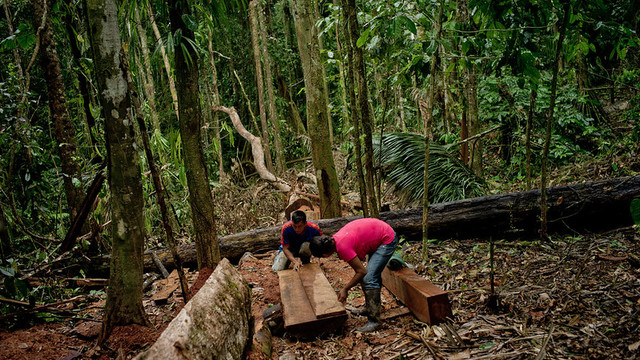CBA14: explore with us how nature-based solutions support local action for adaptation
The ‘nature-based solutions’ track at next month’s 14th annual community-based adaptation event will explore how nature’s ‘services’ can support local communities to manage the impacts of climate change.



Living weir construction based on local knowledge and resources, such as bamboo, to enhance groundwater recharge and water storage for irrigation and other local uses. In Thailand, they are a common water management approach (Photo: copyright GIZ Thailand)
Nature-based solutions (NbS) – whether at local, national or global level – are attracting unprecedented attention among policymakers as strategies for responding and adapting to the climate crisis.
At next month’s 14th annual community-based adaption event (CBA14) NbS will be one of the conference’s five key ‘tracks’. Over the five days, online participants will explore how nature-based solutions can be made to work for people, nature and climate.
So what are NbS? They are approaches inspired and supported by nature that help to address environmental, social and economic challenges. They range from restoring coastal ecosystems that can protect people and places against the impacts of storms, to natural pollinators in agriculture, to creating green roofs in cities to reduce urban heat effects.
Climbing the policy agenda
In a powerful clip released in September 2019, in the lead up to the UN Secretary General’s Climate Change Summit in New York, activist Greta Thunberg and journalist George Monbiot called on the world to 1) protect, 2) restore and 3) fund action for nature, noting "lots of solutions are talked about, but what about a solution that is right in front of us?".
Following the summit, the NbS Coalition led by China and New Zealand released an NbS for Climate Manifesto (PDF), billed as a plan to “unlock the full potential of nature for climate action”.
NbS are also increasingly part of national action plans and commitments for tackling climate change, especially in developing countries. Two-thirds of Nationally Determined Contributions (NDCs) to the Paris Agreement (PDF) include NbS as a way for countries to work towards their climate change mitigation and/or adaptation goals. And all low-income countries included NbS in their NDCs.
How communities are using NbS to adapt
So NbS are making their way on to the policy radar. But how can they accelerate adaptation to climate change for the communities that need it most?
Many of nature’s services underpin human wellbeing and support the resilience of communities, including the poorest, to climate change and other crises. According to the Food and Agricultural Organization of the United Nations, almost 70% of the estimated 1.1 billion people living in poverty depend directly on the productivity of ecosystems for their livelihoods (PDF).
NbS recognise these dependencies and are increasingly used by a variety of sectors and actors to address climate hazards. Based on a recent review (PDF) of around 100 cases, most NbS for adaptation are in the rural livelihoods and food security sector. Urban communities are also adopting NbS to mitigate climate-related flooding, drought and heat.
And NbS are bringing tangible results. A study to empirically evaluate the effectiveness of 13 on-the-ground NbS for adaptation projects around the world showed improvements in community resilience in all 13 sites. Communities increased their adaptive capacity in livelihood and crop diversification, improved knowledge and capacity, reduced disaster risk, and strengthened governance.
Case study: integrating NbS in river basin management in Thailand
Uptake of NbS will ultimately depend on communities and other stakeholders at local and governmental level seeing the benefits.
In Thailand, ‘living weirs’ (weirs made from bamboo and the wide-flung roots of banyan trees) and ‘monkey cheeks’ (natural retention areas to store excess water) are common water management approaches using ecosystem services and community knowledge.
Yet the perceived benefits for communities and the environment have not been assessed in a systematic way.
A joint research partnership with five Thai universities led by the Thai lead water agency, the Office of Natural Water Resources, and supported by the water component of GIZ’s Thai-German Climate Programme, is developing a framework for the systematic monitoring and evaluation (M&E) of the impacts of NbS applied in Thai water management.
To effectively anchor the approach at local level, communities will be encouraged and trained to engage in the M&E, thereby enhancing their stewardship of NbS measures.
These efforts reflect the aim of Thailand’s water sector to step up its adaptation efforts, and deploy NbS for ecosystem-based adaptation (EbA) more widely. To this end, strong emphasis is put on integrating EbA into key planning processes at river basin level.
Based on a climate and vulnerability analysis and a multi-stakeholder process involving river basin committees and community leaders, a range of options for climate-sensitive flood and drought risk management will be integrated into the river basin master plans in the pilot basins of Yom river in the north, and Sakaekrang river in the lower northwest of Thailand.
A code of practice tailored for water management practitioners will guide the design and implementation of NbS measures and will be complemented by the M&E framework to provide a holistic and community-based NbS approach in Thailand’s water sector.
Why join the NbS track at CBA14?
CBA14 will provide a platform for community representatives and other participants to share stories like the one from Thailand. The stories shared and partnerships forged during the conference will build momentum for applying NbS to some of the world’s biggest challenges including:
- Working with nature to make communities more resilient not only to climate risks but to build back better from COVID-19
- Using community-championed nature-based adaptation technologies to make real change on the ground, and
- Supporting community-based organisations to channel finance to scale up local solutions that are environmentally friendly and equitable.
Both the 10-year post-2020 global biodiversity framework set to be adopted at the next Conference of the Parties to the UN Convention on Biological Diversity (CBD COP15) and discussions at the UN climate summit (COP26) next year will likely include a focus on increasing the uptake of NbS.
We need to learn from grassroot experiences to translate the global ambitions of NbS into tangible actions that can, simultaneously, conserve biodiversity, reduce poverty and combat climate change.



